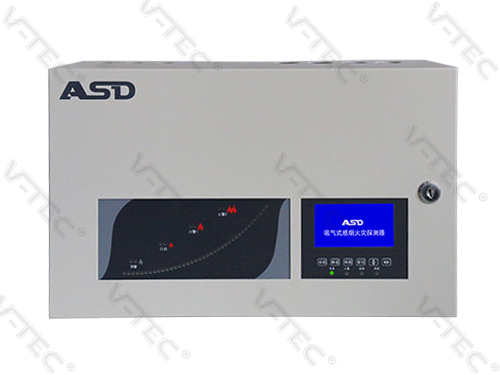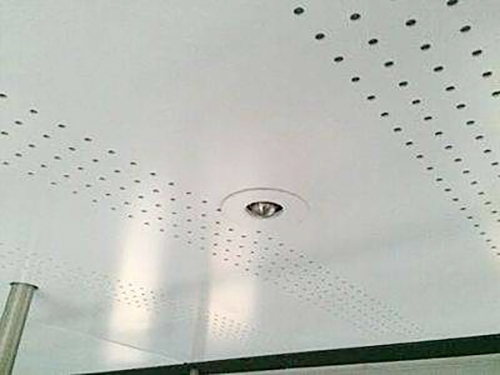Inspiratory smoke fire detector (air sampling type smoke detector) refers to a kind of smoke detection device, which uses the air extraction pump and the sampling pipeline extended to the detection area, as well as the sampling point configured at the appropriate position, to extract the air sample to protect the environment of the object and return it to the high sensitivity air particle detector, analyze the change of smoke concentration, and issue it in case of abnormal change Appropriate alarm.
Sampling tube
The sampling pipe is a pipeline connecting the detection host and the sampling point. The outer diameter of sampling pipe is 25 mm (or 1 inch), and the material is generally ABS or flame-retardant UPVC pipe. In the environment of high and low temperature or corrosion, metal or other materials can also be used.
Sample point / hole
Sampling point or sampling hole is the suction point (hole) of air sample entering the pipeline of detection system. The location of the sampling point must be arranged at the location where the fire smoke appears according to the environmental characteristics of the site. The sampling point can be a hole directly on the sampling pipeline (i.e. the sampling hole). The typical sampling point hole size is 2-4mm.
Extend sample point (hole)
Use a capillary hose or a small diameter rigid pipe (branch pipe) to extend the sampling point (hole) position from the sampling pipeline to the end of the capillary hose or branch pipe.
End pipe plug
The end of the pipeline cannot be open, and the pipe plug must be installed to maintain the suction pressure of the sampling hole on the pipeline. In general application, 4-8mm holes will be opened on the pipe plug to accelerate the flow velocity in the pipeline, while in the application of return air sampling, the holes will not be opened to maintain the large suction pressure of the sampling hole.
Obscuration rate / dimming rate
The obscuration rate or dimming rate refers to the degree to which the advance of light is blocked by smoke. For example, 5% OBS / M (about the sensitivity of ordinary smoke detector) means that the emitted light is blocked (reduced) by 5% in total due to 95% of the original intensity when the smoke particles diffuse in the space reach the receiving point. In addition, the amount of light obscured is also related to the distance. The closer the distance is, the lower the percentage of light obscured is, and the higher the percentage of light obscured is. Therefore, the obscuration rate is defined at a distance of 1 m, i.e. its unit is% OBS / m. The higher the obscuration rate is, the higher the smoke concentration is. The lower the obscuration rate is, the lower the smoke concentration is. Generally, smoke detector uses shielding rate as the index of its ability to detect smoke concentration.

Detection host sensitivity range
It refers to the range of smoke detection of the detection host, and the general alarm threshold can be set freely within the sensitivity range.
Full scale sensitivity
This full scale refers to the fire threshold, not the large value of the range, that is, the smoke concentration when the detection host generates a fire alarm.
Sampling point sensitivity
It refers to the smoke concentration required when the fire smoke enters the sampling pipeline only from the specific sampling point and the detection host reaches the full scale.
Cumulative sensitivity
It refers to the smoke accumulation effect caused by the fire smoke entering the sampling pipeline from several sampling points at the same time, which makes the detection host reach the actual sampling point sensitivity required by the full scale.
System sensitivity
It refers to the smoke concentration in the protection area when the detection host reaches the full scale. The sensitivity of the system is related to the full scale sensitivity of the detection host, the number of sampling points and the number of fire smoke entering the sampling points. In extreme cases, the system sensitivity may be equal to the sampling point sensitivity, i.e. the fire smoke will only enter the pipeline system from one sampling point; the system sensitivity may also be equal to the detection host sensitivity, in which case the smoke generated by the fire will enter from all sampling points at the same time. Generally, the sensitivity of the system is between the two.

Effective sensitivity
It refers to the actual amount of smoke that needs to be increased to reach the relevant sensitivity due to the background smoke concentration in the environment.
General sensitivity
It means that the system sensitivity of the air sampling smoke detection system is equivalent to that of the ordinary detector. The sensitivity of ordinary point smoke detector is between 5% OBS / M and 15% OBS / m.
Enhanced sensitivity
It means that the sensitivity of the system is between 0.8% OBS / M and 2% OBS / m.
Very high sensitivity
It means that the system sensitivity of air sampling smoke detection system is higher than 0.8% OBS / m.
End test
In order to detect the large transmission time at the end of the pipe or judge whether the sampling pipeline is broken or blocked, introduce appropriate amount of smoke at the end of the sampling pipeline during commissioning, acceptance or maintenance to observe whether the detection host can react within the expected time.
Detection area
In order to detect the position of fire in the protected area quickly and accurately, the protected area is divided into several detection areas according to the appropriate area size and use or characteristics, and displayed on the fire alarm controller.
Alarm area
The warning range of the automatic fire alarm system is divided into units according to the fire compartment or floor. An alarm area may contain more than one detection area, otherwise it is not.
Fire compartment
It refers to the local area divided by fire separation measures that can prevent the fire from spreading to the rest of the same building in a certain period of time.
Protection area of sampling hole
The protection area of the detector is defined as the effective detection area of a fire detector, and the protection area of the sampling hole is equivalent to the protection area of the point type smoke detector.
Sampling hole protection radius
The protection radius of a fire detector is defined as a unidirectional large horizontal distance which can be effectively detected by a fire detector. The protection radius of sampling hole is equivalent to the protection area of point type smoke detector.
Transmission time
The time when the air sample is transmitted from the sampling hole to the detection host in the sampling pipeline.
Phase alert
The air sampling system has a wide range of sensitivity detection, which can generate multi-stage and phased alarms to execute corresponding strategies or actions when the corresponding fire is large. Generally speaking, the early warning signal generated in the small smoke stage can inform the management personnel as a reminder of environmental abnormalities. The fire alarm signal generated in the large smoke stage can be moved to the fire alarm controller, notify the fire brigade, power off the equipment or turn off the air conditioning system And so on to avoid the expansion of the disaster.
Standard sampling / under ceiling sampling
Sampling pipeline and sampling point are equipped with air sampling mode under the ceiling. Each sampling point (hole) in this mode is equivalent to point type smoke detector.
Capillary sampling
Rather than making a hole directly on the sample run as a sample hole, you can also use a capillary hose or branch pipe to extend the sample point from the sample run to the appropriate location. This method is often used in the case of concealed installation or cabinet sampling.
Cabinet sampling
Relative to the protection of the whole area, the focus of cabinet sampling detection is the equipment inside the cabinet. In this application, capillary hose or branch pipe is usually used to extend the sampling point to the inside of the cabinet.
Return air sampling
Because of the high-speed air flow in the detection area, the sampling point is arranged in the return air path to intercept the fire smoke. The return air sampling can generally achieve the very early fire smoke detection effect.
Air duct sampling
An air sampling method that configures a sampling point in a duct, which is a type of return air sampling.

Serve you 24 hours, solve your needs and share your doubts
 | TEL:021-51090861 E-MAIL:office@v-tecfire.com FAX:021-37560538 ZIP CODE:210040 ADD:Third floor, building 2, No. 6400, Hangnan Road, Fengxian District, Shanghai China |
To eliminate fire and build social security with innovative technology